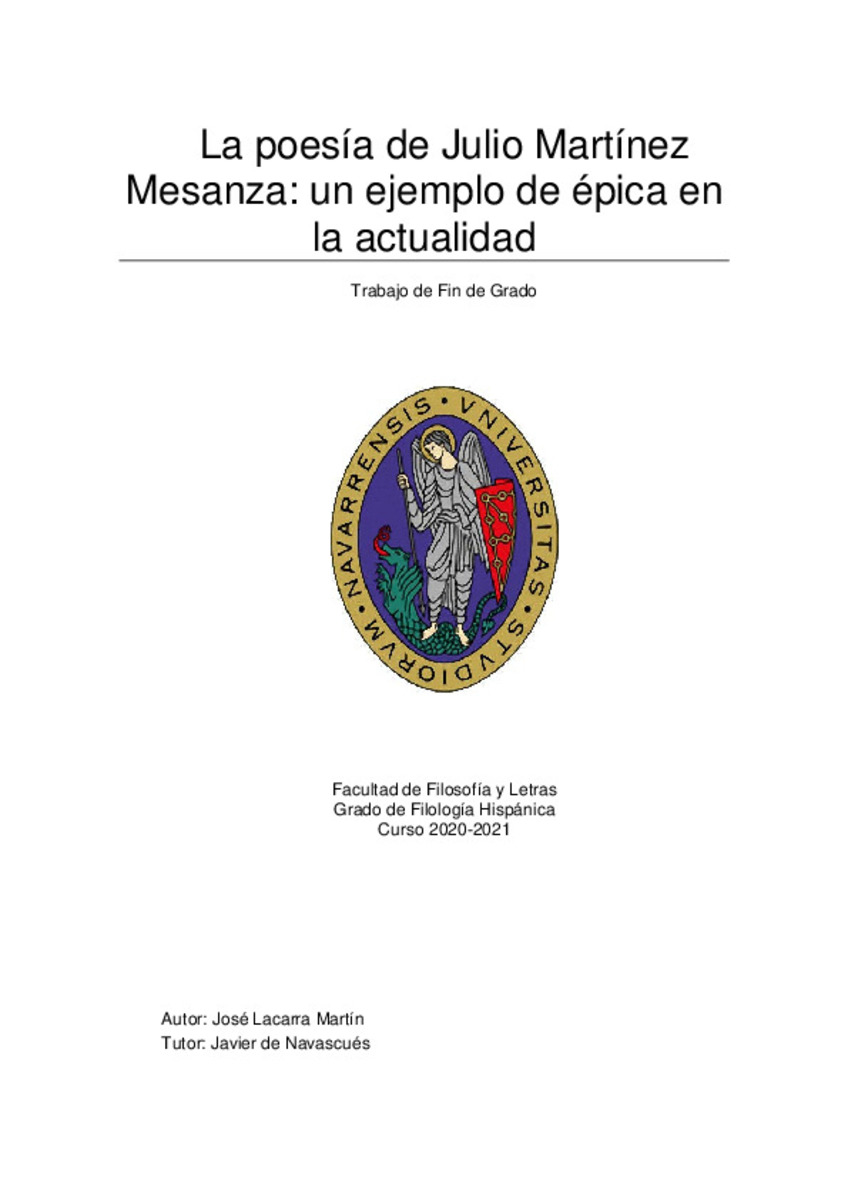Registro completo de metadatos
| Campo DC | Valor | Lengua/Idioma |
|---|---|---|
| dc.contributor.advisor | Navascués-Martín, J. (Javier) de | - |
| dc.creator | Lacarra-Martín, J. (José) | - |
| dc.date.accessioned | 2021-11-19T10:46:50Z | - |
| dc.date.available | 2021-11-19T10:46:50Z | - |
| dc.date.issued | 2021 | - |
| dc.date.submitted | 2021 | - |
| dc.identifier.uri | https://hdl.handle.net/10171/62604 | - |
| dc.description.abstract | Cuando en los años ochenta Julio Martínez Mesanza publicó Europa, la crítica definió sus versos como épicos. Tanto las posteriores reediciones del poemario como la aparición de su segundo libro, Las trincheras, fueron leídos por antólogos y reseñistas bajo esa misma perspectiva. Sin embargo, en los últimos veinte años se ha modificado la mirada sobre su obra. La escritura de Entre el muro y el foso y Gloria, que dejan prácticamente de lado la línea bélica que había seguido el poeta al comienzo de su carrera, han acentuado este cambio. El propósito de este trabajo es dar fundamento teórico a aquella crítica de las primeras publicaciones de Martínez Mesanza, que intuyó el vínculo que las estrofas endecasilábicas del poeta tenían con el género épico. Si interpretamos los cuatro poemarios de forma unitaria comprobamos que el poeta ha creado un universo homogéneo en que sus composiciones guardan una estrecha relación entre sí, creando una narrativa épica. Para ello, me apoyo en las nociones de cuatro teóricos de la épica que han trabajado a lo largo de los siglos XX y XXI: Lukács, Goyet, Bowra y Quint. | es_ES |
| dc.description.abstract | When in the eighties Julio Martínez Mesanza published Europa, literary critics defined his verses as epic. Both posterior re-editions of the poetry book and the appearance of his second collection, Las trincheras, were seen by anthologists and reviewers under that same perspective. However, in the last twenty years his work has been read under a different view. The writing of Entre el muro y el foso and Gloria, both of which greatly steer away from the belic line that has followed the poet from the beginning of his career, have accentuated this change. The purpose of this work is to give theoretical basis to those voices of his first publications that sensed the link between Martinez Mesanza’s eleven-syllable verses and the epic genre. If we interpret the four poetry books in a unitarian way, we understand that the poet has created an homogeneous universe in which his compositions maintain a close relationship between each other, creating an epic narrative. For this, I have based myself in the notions of four epic theorists that have worked on the topic during the 20th and 21st centuries: Lukács, Goyet, Bowra and Quint. | es_ES |
| dc.language.iso | spa | es_ES |
| dc.rights | info:eu-repo/semantics/openAccess | es_ES |
| dc.subject | Materias Investigacion::Filología y Literatura | es_ES |
| dc.subject | Épica | es_ES |
| dc.subject | Julio Martínez Mesanza | es_ES |
| dc.subject | Poema | es_ES |
| dc.subject | Postmodernismo | es_ES |
| dc.subject | Epic | es_ES |
| dc.subject | Poem | es_ES |
| dc.subject | Postmodernism | es_ES |
| dc.title | La poesía de Julio Martínez Mesanza: un ejemplo de épica en la actualidad | es_ES |
| dc.type | info:eu-repo/semantics/bachelorThesis | es_ES |
Ficheros en este ítem:
Estadísticas e impacto
Los ítems de Dadun están protegidos por copyright, con todos los derechos reservados, a menos que se indique lo contrario.






